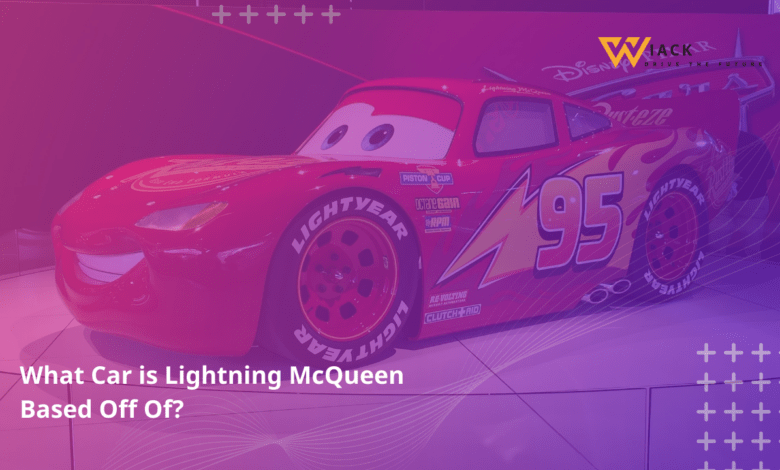What Car is Lightning McQueen Based Off Of?

Did you know that Lightning McQueen, the beloved character from Pixar’s “Cars” franchise, was designed after studying over 500 different car models? This surprising fact highlights the incredible attention to detail and creativity that went into crafting one of animation’s most iconic vehicles. In this comprehensive guide, we’ll explore the various influences and inspirations behind Lightning McQueen’s unique design, delving into the world of stock cars, Le Mans racers, and classic American muscle cars.
Lightning McQueen’s Design: A Hybrid of Stock Cars and Le Mans Racers
Lightning McQueen’s design is a masterful blend of different automotive styles, combining elements from both stock cars and Le Mans racers. This unique fusion creates a character that is both familiar and distinct, appealing to racing enthusiasts and casual viewers alike. Let’s take a closer look at the specific influences that shaped Lightning McQueen’s appearance.
Stock Car Influences
Stock car racing, particularly NASCAR, played a significant role in shaping Lightning McQueen’s overall silhouette and proportions. The following features of Lightning McQueen’s design draw heavily from stock cars:
- Aerodynamic body shape: Lightning McQueen’s sleek, streamlined form is reminiscent of NASCAR vehicles designed for high-speed oval track racing.
- Wide stance: The character’s broad, stable posture is typical of stock cars built for stability at high speeds.
- Large rear spoiler: This prominent aerodynamic feature is a staple of stock car design, helping to generate downforce for better traction.
- Decals and sponsor logos: While not based on real-world brands, the abundance of colorful decals on Lightning McQueen’s body is a nod to the sponsor-heavy aesthetic of stock car racing.
- Exposed headlights: Unlike modern NASCAR vehicles, Lightning McQueen sports exposed headlights, a feature more common in earlier stock car designs.
The stock car influence gives Lightning McQueen a sense of power and speed, essential qualities for a character meant to embody the spirit of racing.
Le Mans Racer Influences
While stock cars form the foundation of Lightning McQueen’s design, elements from Le Mans racers add a touch of sophistication and international flair. These influences include:
- Low profile: Lightning McQueen’s ground-hugging stance is more reminiscent of Le Mans prototypes than the higher-riding stock cars.
- Smooth curves: The flowing lines of Lightning McQueen’s body, particularly around the wheel arches, draw inspiration from sleek European race cars.
- Cockpit design: The character’s windshield and cabin area bear a closer resemblance to the enclosed cockpits of Le Mans racers than the more open design of stock cars.
- Mid-engine appearance: While not explicitly stated, Lightning McQueen’s proportions suggest a mid-engine layout, common in many Le Mans prototypes.
- Advanced lighting: The character’s expressive eyes, which double as headlights, are more sophisticated than typical stock car lighting, hinting at the advanced technology found in Le Mans racers.
By incorporating these Le Mans-inspired elements, the designers gave Lightning McQueen a more diverse and international appeal, making him stand out from typical American race cars.
Real-Life Cars that Inspired Lightning McQueen
While Lightning McQueen is a unique creation, several real-world vehicles influenced his design. Let’s explore some of the most significant inspirations behind this iconic character.
Chevrolet Corvette C6
The Chevrolet Corvette C6, produced from 2005 to 2013, shares several design cues with Lightning McQueen:
- Sleek profile: Both the Corvette C6 and Lightning McQueen feature a low, aerodynamic silhouette.
- Pronounced fenders: The bulging wheel arches are a signature element of both designs.
- Short rear deck: Lightning McQueen’s compact rear end echoes the Corvette’s tidy tail section.
- Aggressive front fascia: The determined expression of Lightning McQueen mirrors the Corvette’s bold front-end design.
The Corvette’s influence adds a touch of American sports car flair to Lightning McQueen’s character, blending performance with style.
Chevrolet Corvette C6.R
The racing variant of the Corvette C6, known as the C6.R, also played a role in shaping Lightning McQueen’s appearance:
- Wide body kit: The exaggerated width of Lightning McQueen’s body is reminiscent of the C6.R’s flared fenders.
- Large rear wing: While not identical, Lightning McQueen’s spoiler shares similarities with the prominent aerodynamic devices found on the C6.R.
- Racing livery: The bold graphics and number placement on Lightning McQueen draw inspiration from the C6.R’s racing livery.
- Exposed headlights: Unlike many modern race cars, both Lightning McQueen and the C6.R feature visible headlight units.
The influence of the C6.R adds authentic racing DNA to Lightning McQueen’s design, grounding the character in real-world motorsport aesthetics.
Ford Shelby GT500 Mustang
Elements of the Ford Shelby GT500 Mustang can also be seen in Lightning McQueen’s design:
- Muscular proportions: The powerful, athletic stance of Lightning McQueen echoes the Shelby GT500’s imposing presence.
- Long hood: While not as pronounced, Lightning McQueen’s front end hints at the Shelby’s iconic long hood design.
- Grille design: The shape of Lightning McQueen’s grille bears some resemblance to the Shelby GT500’s distinctive front end.
- Performance-oriented aesthetics: Both designs emphasize speed and power through their visual language.
The Shelby GT500’s influence adds a dose of American muscle car attitude to Lightning McQueen’s character, enhancing his appeal to fans of classic high-performance vehicles.
Porsche 911 Carrera 4S
Surprisingly, traces of the Porsche 911 Carrera 4S can be found in Lightning McQueen’s design:
- Rounded fenders: The smooth, curved fenders of Lightning McQueen share similarities with the 911’s iconic shape.
- Sloping rear end: While not as pronounced, Lightning McQueen’s tail section hints at the 911’s distinctive sloping rear.
- Headlight shape: The oval-shaped headlights (eyes) of Lightning McQueen bear some resemblance to the 911’s headlight design.
- Overall proportions: The compact yet powerful appearance of both designs creates a sense of agility and speed.
The subtle influence of the Porsche 911 adds a touch of European sports car elegance to Lightning McQueen’s design, broadening his international appeal.
By drawing inspiration from these diverse real-world vehicles, the creators of Lightning McQueen crafted a character that feels both familiar and unique, capable of capturing the imagination of car enthusiasts and casual viewers alike.
Lightning McQueen’s Unique Features
While Lightning McQueen draws inspiration from various real-world cars, he also possesses several unique features that set him apart and contribute to his iconic status. Let’s explore these distinctive elements that make Lightning McQueen truly one-of-a-kind.
The “95” Racing Number
One of the most recognizable aspects of Lightning McQueen’s design is his racing number, 95. This number holds special significance:
- Pixar reference: The number 95 is a nod to 1995, the year Pixar released its first feature film, “Toy Story.”
- Visual balance: The two-digit number fits perfectly on Lightning McQueen’s doors and hood, creating a visually pleasing layout.
- Memorable branding: The distinctive “95” has become synonymous with Lightning McQueen, appearing on countless pieces of merchandise.
- Character development: Throughout the “Cars” franchise, the number 95 becomes a symbol of Lightning McQueen’s journey and legacy.
The choice of 95 as Lightning McQueen’s racing number demonstrates how even small details can contribute significantly to a character’s identity and appeal.
The Lightning Bolt Decal
Another iconic element of Lightning McQueen’s design is the stylized lightning bolt decal that adorns his sides:
- Name representation: The lightning bolt is a visual representation of the character’s first name, creating a strong connection between his appearance and identity.
- Dynamic imagery: The bolt design suggests speed and electricity, reinforcing Lightning McQueen’s reputation as a fast and energetic racer.
- Unique identifier: The distinctive shape of the lightning bolt helps Lightning McQueen stand out from other characters and real-world race cars.
- Merchandising potential: The simple yet effective design of the lightning bolt lends itself well to various merchandise applications, from toys to clothing.
The lightning bolt decal serves as a perfect example of how graphic design can enhance a character’s visual appeal and reinforce their personality traits.
The Red Paint Job
Lightning McQueen’s vibrant red paint job is more than just an aesthetic choice:
- Emotional impact: Red is often associated with excitement, energy, and passion – all qualities that align with Lightning McQueen’s personality.
- Visual prominence: The bright red color ensures that Lightning McQueen stands out on screen, drawing the viewer’s attention.
- Racing tradition: Red has a long history in motorsports, particularly with iconic brands like Ferrari, adding a sense of racing heritage to the character.
- Contrast with other characters: The bold red color helps differentiate Lightning McQueen from other characters in the “Cars” universe, many of whom sport different color schemes.
The choice of a red paint job for Lightning McQueen demonstrates how color can be used to reinforce character traits and create a strong visual identity.
By combining these unique features with elements inspired by real-world vehicles, the creators of Lightning McQueen developed a character that is both familiar and distinctively original. These design choices have played a crucial role in making Lightning McQueen one of the most recognizable and beloved animated characters of the 21st century.
Debates and Speculation About Lightning McQueen’s Car
Despite the clear influences from various real-world vehicles, there has been ongoing debate and speculation among fans about what specific car Lightning McQueen might be based on. Let’s explore some of the popular theories and examine their merits.
Is Lightning McQueen a Subaru BRZ?
One theory that has gained traction online is that Lightning McQueen is based on the Subaru BRZ. While there are some similarities, this theory doesn’t hold up to scrutiny:
- Timeline mismatch: The first “Cars” movie was released in 2006, while the Subaru BRZ wasn’t introduced until 2012.
- Design differences: The BRZ has a more angular design compared to Lightning McQueen’s smoother curves.
- Size and proportions: The BRZ is a compact sports car, while Lightning McQueen’s proportions suggest a larger vehicle.
- Racing pedigree: The BRZ, while sporty, doesn’t have the same racing heritage as the NASCAR and Le Mans-inspired elements in Lightning McQueen’s design.
While the Subaru BRZ is an impressive sports car in its own right, it’s unlikely to have been a direct inspiration for Lightning McQueen’s design.
Is Lightning McQueen a Ford GT?
Another popular speculation is that Lightning McQueen is based on the Ford GT. This theory has a bit more merit:
- Similar proportions: Both the Ford GT and Lightning McQueen feature a low, wide stance.
- Racing heritage: The Ford GT has a strong connection to Le Mans racing, which aligns with some of Lightning McQueen’s design elements.
- American roots: As an American-made supercar, the Ford GT fits with Lightning McQueen’s all-American persona.
However, there are also significant differences:
- Front-end design: The Ford GT’s distinctive nose is quite different from Lightning McQueen’s more traditional front end.
- Mid-engine layout: The Ford GT is clearly a mid-engine design, while Lightning McQueen’s engine placement is less obvious.
- Overall shape: The Ford GT has a more angular, wedge-like shape compared to Lightning McQueen’s rounded form.
While the Ford GT may have influenced some aspects of Lightning McQueen’s design, it’s unlikely to be the primary inspiration.
Is Lightning McQueen a Camaro?
Some fans have suggested that Lightning McQueen might be based on a Chevrolet Camaro. Let’s examine this theory:
- American muscle car heritage: The Camaro’s status as an iconic American performance car aligns with Lightning McQueen’s character.
- Front-end similarities: Some generations of the Camaro share a similar front grille design with Lightning McQueen.
- Performance reputation: Like Lightning McQueen, the Camaro is known for its speed and power.
However, there are also notable differences:
- Overall proportions: The Camaro typically has a longer hood and more pronounced rear quarters than Lightning McQueen.
- Racing focus: While the Camaro has been used in various forms of racing, it’s not as closely associated with NASCAR or Le Mans as some other vehicles.
- Design era: Lightning McQueen’s design seems to draw more from modern sports cars than the retro-inspired look of recent Camaros.
While the Camaro may have contributed some design cues, it’s unlikely to be the primary basis for Lightning McQueen’s character.
In reality, Lightning McQueen is a composite character, drawing inspiration from multiple sources rather than being based on any single real-world vehicle. This approach allows him to embody the essence of high-performance racing cars while maintaining a unique and instantly recognizable appearance.
The ongoing debates about Lightning McQueen’s real-world counterpart demonstrate the character’s broad appeal and the success of his design in capturing the imagination of car enthusiasts. By blending elements from various iconic vehicles, the creators of Lightning McQueen developed a character that feels authentic to the world of racing while still being distinctively his own.
Lightning McQueen’s Personality and Character Development
While Lightning McQueen’s design is crucial to his appeal, his personality and character development throughout the “Cars” franchise are equally important. Let’s explore how Lightning McQueen’s character evolves and the lessons he learns along the way.
From Cocky Rookie to Humble Champion
When we first meet Lightning McQueen in the original “Cars” movie, he’s a brash, overconfident rookie racer:
- Initial arrogance: Lightning starts as a self-centered character, focused solely on winning and fame.
- Lack of teamwork: He initially dismisses the importance of his pit crew and support team.
- Impatience: Lightning is always in a rush, unable to appreciate the journey or the world around him.
However, through his experiences in Radiator Springs and his interactions with its residents, Lightning undergoes a significant transformation:
- Humility: He learns to appreciate the wisdom and skills of others, particularly Doc Hudson.
- Friendship: Lightning forms genuine connections with the residents of Radiator Springs, especially Mater.
- Community: He discovers the value of being part of a community and giving back to others.
- Balance: Lightning learns to balance his competitive drive with other aspects of life, such as friendship and personal growth.
By the end of the first movie, Lightning has evolved into a more mature, well-rounded character who values relationships and sportsmanship as much as winning.
The Importance of Teamwork and Friendship
Throughout the “Cars” franchise, Lightning McQueen’s relationships with other characters play a crucial role in his development:
- Mater: His friendship with Mater teaches Lightning the value of loyalty and enjoying life’s simple pleasures.
- Sally: Lightning’s relationship with Sally helps him appreciate beauty beyond the racetrack and consider settling down.
- Doc Hudson: As a mentor figure, Doc Hudson helps Lightning understand the deeper aspects of racing and life.
- Pit crew: Lightning learns to value and trust his support team, recognizing that success in racing is a group effort.
These relationships not only contribute to Lightning’s personal growth but also add depth and heart to the stories, making them appealing to audiences of all ages.
Facing Down a New Generation of Racers
In “Cars 3,” Lightning McQueen faces a new challenge: competing against a younger generation of high-tech racers. This storyline allows for further character development:
- Adapting to change: Lightning must learn to adapt to new technologies and training methods to stay competitive.
- Mentorship: Drawing on lessons from his own experiences with Doc Hudson, Lightning takes on a mentorship role with Cruz Ramirez.
- Legacy: Lightning begins to consider his impact on the sport and what he wants to leave behind.
- Graceful transition: He learns to accept that he can’t race forever and finds new ways to stay involved in the sport he loves.
This arc demonstrates how Lightning McQueen’s character continues to evolve, facing new challenges and growing in different ways throughout the franchise. It also provides valuable lessons for viewers about adapting to change, mentoring others, and finding new ways to pursue one’s passions as circumstances change.
Lightning McQueen’s character development throughout the “Cars” series serves several important purposes:
- Relatable growth: Viewers of all ages can relate to Lightning’s journey of self-improvement and learning life lessons.
- Moral lessons: His experiences teach valuable lessons about humility, friendship, and the importance of personal growth.
- Emotional depth: The character’s evolution adds emotional depth to the stories, making them more engaging for audiences.
- Franchise longevity: By allowing the character to grow and face new challenges, the franchise remains fresh and relevant across multiple films.
Through Lightning McQueen’s personal journey, the “Cars” franchise delivers entertaining stories that also carry meaningful messages about character, perseverance, and the value of relationships.
Lightning McQueen’s Legacy
As one of the most recognizable characters in modern animation, Lightning McQueen has left a significant mark on popular culture. Let’s explore the various aspects of his enduring legacy.
A Beloved Character in the “Cars” Franchise
Lightning McQueen’s impact on the “Cars” franchise cannot be overstated:
- Box office success: The “Cars” movies have grossed over $1.4 billion worldwide, with Lightning McQueen as the central character.
- Critical acclaim: While reception has varied across the trilogy, the first “Cars” movie received an Academy Award nomination for Best Animated Feature.
- Franchise expansion: Lightning McQueen’s popularity has led to short films, TV series, and theme park attractions based on the “Cars” universe.
- Character recognition: Lightning McQueen has become one of Pixar’s most recognizable characters, alongside Woody and Buzz Lightyear from “Toy Story.”
The success of Lightning McQueen and the “Cars” franchise demonstrates the character’s strong appeal and the effectiveness of his design and personality in capturing audiences’ imaginations.
A Popular Figure in Pop Culture
Beyond the movies, Lightning McQueen has become a significant presence in popular culture:
- Merchandising: Lightning McQueen appears on a vast array of products, from toys and clothing to bedding and school supplies.
- Video games: The character has featured in numerous video games, allowing fans to race as Lightning McQueen.
- Theme park attractions: Lightning McQueen is a central figure in “Cars Land” at Disney California Adventure and similar attractions at other Disney parks worldwide.
- Marketing partnerships: The character has been used in marketing campaigns for various brands, particularly in the automotive and racing industries.
- Social media presence: Lightning McQueen has a significant following on social media platforms, with official accounts sharing content and engaging with fans.
This widespread presence in popular culture ensures that Lightning McQueen remains relevant and beloved even between movie releases.
Inspiration for Young Fans
Perhaps most importantly, Lightning McQueen serves as an inspiration for many young fans:
- Interest in racing: The character has sparked an interest in motorsports among many children, potentially inspiring future racers and engineers.
- Lessons in perseverance: Lightning McQueen’s journey teaches young viewers about the importance of hard work and never giving up.
- Emotional intelligence: The character’s growth demonstrates the value of emotional intelligence and the importance of relationships.
- Creativity and design: Lightning McQueen’s unique design has inspired many young artists and designers, encouraging creativity in automotive design.
- Role model: Despite his initial flaws, Lightning McQueen’s growth throughout the series makes him a positive role model for young viewers.
By inspiring and educating young fans, Lightning McQueen’s legacy extends far beyond entertainment, potentially influencing future generations in positive ways.
Lightning McQueen’s enduring popularity and cultural impact demonstrate the power of well-crafted animated characters. By combining an appealing visual design with relatable personality traits and meaningful character development, the creators of Lightning McQueen have produced a character that resonates with audiences of all ages.
As we’ve explored throughout this article, the question “What car is Lightning McQueen based off of?” doesn’t have a simple answer. Instead, Lightning McQueen represents a masterful blend of various automotive influences, creative design choices, and character development. This unique combination has resulted in a character that feels both familiar and distinct, capable of capturing the imagination of car enthusiasts and casual viewers alike.
From his stock car and Le Mans racer influences to his real-world inspirations like the Chevrolet Corvette and Ford GT, Lightning McQueen’s design draws from a rich automotive heritage. Yet, it’s the character’s unique features – his “95” racing number, lightning bolt decal, and vibrant red paint job – that truly set him apart and make him instantly recognizable.
Moreover, Lightning McQueen’s journey from a cocky rookie to a humble champion, and later to a mentor facing a new generation of racers, provides depth and relatability to the character. These elements of personal growth and the lessons learned along the way have helped the “Cars” franchise resonate with audiences beyond just car enthusiasts.
In conclusion, Lightning McQueen’s design is a testament to the creativity and attention to detail of the Pixar team. By creating a character that isn’t based on any single real-world car but instead embodies the spirit of racing and the essence of speed, they’ve crafted an icon that continues to captivate audiences and inspire young fans around the world. Lightning McQueen’s legacy serves as a reminder of the power of thoughtful character design and storytelling in creating enduring, beloved figures in animation and popular culture.
Get the latest car news, reviews, and prices at Wiack.com. Your one-stop destination for all things automotive.





